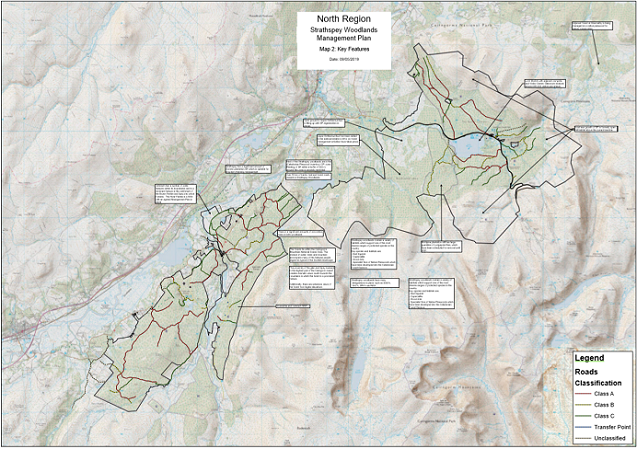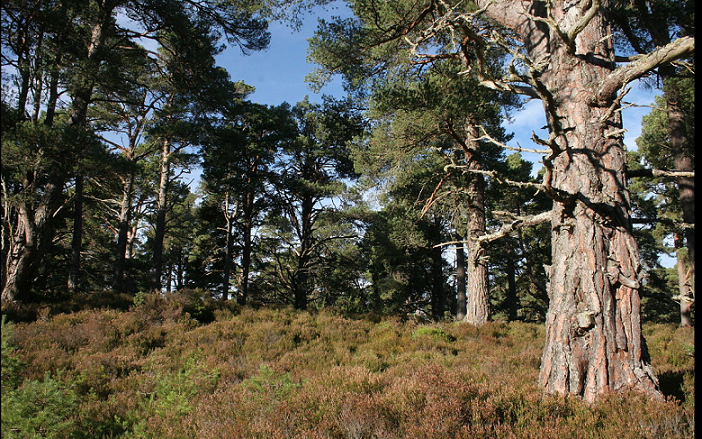
In Autumn last year, Forestry and Land Scotland (FLS) put the next update of the Local Management Plan for the Strathspey Forest out for consultation until March 2020. Please look at the documents (see here) and send your views into FLS.
This forest is important because it attracts a lot of tourist visits, 350,000 last year, and surrounds areas of high conservation value. The tourist visits are key to the Strathspey economy currently suffering from poor skier numbers, made worse by the closure of the funicular. The forest is an important habitat, sustaining a variety of wildlife and buffering the rare mountain habitats from the surrounding tourist pressures. Like all forests in Scotland, it also provides essential local employment.

The FLS consultation plan has much to be pleased about. The recreational value and social importance of forests feature prominently. Water, biodiversity and landscape are all given higher priority than timber production, although we will all be able to think of clear-felling eyesores that imply different priorities at a working level.
However, there are some gaps. Closer inspection of the plan outcomes reveals the reason why; the applicable standards are all standard forest documents, designed around the objective of timber production. However, Strathspey is not a typical forest. As pointed out above, its role in both the local economy and as a wildlife refuge requires planners to look outside of the box. FLS know this and, of course, do a lot to help these objectives. However, maybe now the time is right to change the standards for forests such as Strathspey.
A section on managing the tourist pressures, dealing with the large number of camper vans and the interaction of mountain bikers and walkers on the forest paths would be helpful not only to the public but to FLS staff who have to manage these conflicts on a daily basis during the summer.

The plan rightly recognises that the forest has a key role in improving water quality and in regulating flood water entering the River Spey. Allowing the streams and higher reaches of the rivers to cut their own course, letting woody debris remain in the streams and rivers spreads flood peak flows and reduces erosion causing less silt to enter the Spey. Restoration of wetlands and woodland bogs ensures that any eroded soil gets trapped before entering the river. This Natural Flood Management is official Government Policy. However, there are no details given about how FLS will achieve this. Given the importance of fishing on the Spey and its importance to species such as freshwater mussels, this is a significant omission.
The devastation caused in Ballater by Storm Frank in 2015 shows the need to manage our upland rivers differently and the experts agree that Natural Flood Management is the way forward. It’s disappointing that more concrete plans aren’t available for what must be one of the best test sites in the country. The plan talks about building resilience to a changing climate. Natural Flood Management and riparian planting of broad leaved trees to shade the water are good examples of what is needed. Clear targets are needed so that we can measure progress.
The significance of the forest in encouraging the natural spread, without replanting, of one of the largest remaining fragments of the Old Caledonian Pine Forest that once covered much of Scotland needs to be written large. The plan acknowledges this but fails to grasp the opportunity to mobilise positive public opinion.
The plan almost fails to mention Cairngorms Connect; the initiative that aims to connect the rewilding ongoing at Glenfeshie right through to the ongoing work to expand the Old Caledonian Pine Forest at Abernethy. The aim is to form a large area where natural processes take precedence. http://www.cairngormsconnect.org.uk/

The website talks of “bold and ambitious” and it is. This is not PR hyperbole but a genuine attempt by neighbouring estates to create a large habitat, unique in UK terms, that will be big enough for species to move and adapt to climate change. Natural flood plains and tree lines are not only nicer to look at but reduce flooding risk and allow wildlife space to adapt.
Strathspey forest is key to this initiative. It lies between the two “conservation” estates and needs to form a link that wildlife can use when moving between these estates. FLS is keen to play its part but there are no sketches showing possible corridors and how these might interact with commercial forestry or how they might be used to encourage visitors without disturbing the wildlife that they come to see. To be fair, there are few details on the Cairngorms Connect website. This might be due to uncertainty in what mechanisms will replace EU funding or in agreeing plans across estate boundaries. Whatever the reason, we can’t all wait for each other and I encourage FLS to start developing this sort of thinking.

Here in the Borders I note that FLS has started to deal with the mountain bike/house riding/walking conflict by starting to construct ‘walking paths’… with polite notices and bike gates to keep the bikes off them. We’re also starting to see groups being set up to educate cyclists of the danger to horse riders of inconsiderate trail use. I expect it’s inevitable that both will become more common.
Thanks, David, you have made some very important points in your blog. I think FLS is trying to do the right thing, but as you say, is somewhat constrained by its past. I will aim to provide comments on this FLS consultation, and hopefully many others reading this blog will also comment.
What about biodiversity??? Small stuff and also BIG stuff like beavers and lynx???
Sue, I completely agree but maybe we have to get FLS to walk before we ask them to run?